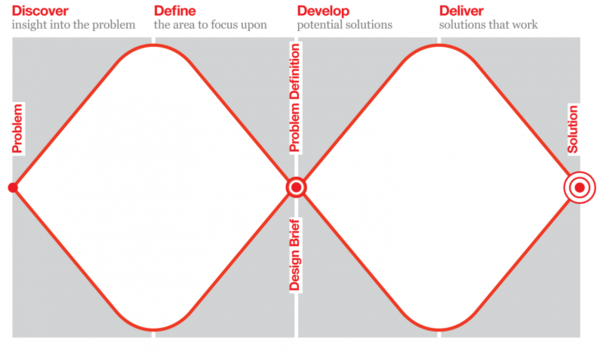Human-centered Storytelling
How Design Thinking improves audiences-driven journalism.
Design Thinking has become a major buzzword in the last few years. It is clear that Design Thinking is not the solution for everything. However, as a human-centred framework that “integrates the needs of people, the possibilities of technology, and the requirements for business success” (Tim Brown), Design Thinking may provide a useful process for public-powered journalism.
In a research paper for my master’s degree in Digital Management at Hyper Island, I explored the ways Design Thinking could be applied in journalism. This article is a comprehensive summary of said paper as well as a start for further discussions and improvements.
Let’s take a look at the Design Thinking process as described by the British Design Council.

It starts with a problem statement. After that, there are four phases visualized by a double diamond:
- Discover: Gaining insights into the problem
- Define: Synthesizing research findings
- Develop: Ideating potential solutions
- Deliver: Implementing a solution that works
Sometimes a fifth phase is added to show that the delivered solution is iterated over and over. Dan Nessler, a Hyper Island alumni and Head of UX at Hinderling Volkart, wrote a comprehensive guide to the Design Thinking process if you want to dig deeper into that topic.
Why should Design Thinking be applied in journalism?
The general definition of journalism may be summarized in three services to society: Information, explanation, and classification. But: “The bulk of news stories get created without the customers (the audience) meaningfully involved in the decisions that shape the product (the story),” writes Jennifer Brandel, CEO of Hearken. Interaction with the “people formerly known as the audience” usually happens after the publication.
However, many studies indicate a positive effect on business success in media companies that engage with their users early on. So it’s quite a paradox that most journalists believe that their work is vital to serving the public interest but are wary of allowing readers to dictate what’s newsworthy. There’s an excellent paper by James G. Robinson about the journalist’s perception of their readers.
Today, journalism is competing in the rambling attention economy of the internet. The competitors are not only other publishers but social media platforms as well. It is, therefore, essential to attract attention by focusing on people’s needs. Also, the world is getting more interconnected, and humanity tackles complex problems. A focus on the readers’ questions helps journalism to fulfil its purpose in society.
Design Thinking can help to achieve a higher engaged community and erase the gut feeling about interests and relevance by actively including the readers in the process. However, this does not conclude that the readers will make every decision. In terms of journalism, the newsroom still can decide but always with the reader in mind. The success stories also show the economic viability of a human-centred storytelling approach. The publishers are struggling with financial sustainability. Therefore, it is crucial to focus the resources at hand on the people’s needs.
Moreover, a loyal audience is vital for business success, whether the publisher bets on ad revenue, memberships, contributions, or subscriptions.
Introducing the Human-centered Storytelling framework
Keeping the readers in mind has already become a habit in many newsrooms. However, the idea of including them in the editorial process feels worrisome and abstract to the reporters I interviewed for the research paper.





